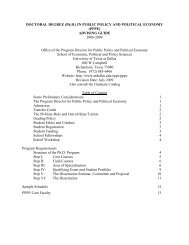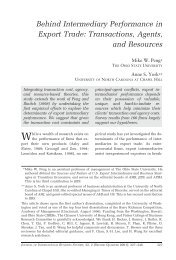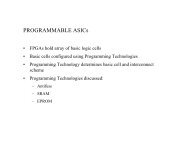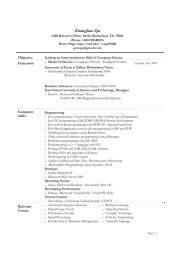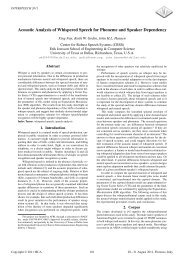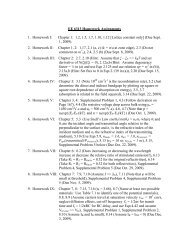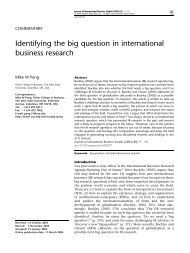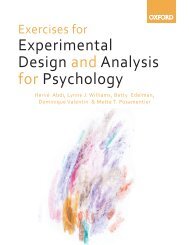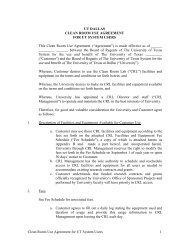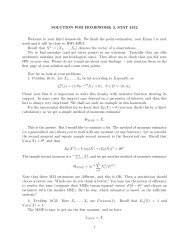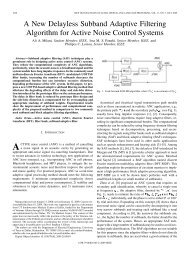OPRE 6302 on 20 March 2008 - The University of Texas at Dallas
OPRE 6302 on 20 March 2008 - The University of Texas at Dallas
OPRE 6302 on 20 March 2008 - The University of Texas at Dallas
Create successful ePaper yourself
Turn your PDF publications into a flip-book with our unique Google optimized e-Paper software.
I understand th<strong>at</strong><br />
<str<strong>on</strong>g>OPRE</str<strong>on</strong>g> <str<strong>on</strong>g>6302</str<strong>on</strong>g> <strong>on</strong> <strong>20</strong> <strong>March</strong> <strong>20</strong>08<br />
- This is a closed books/notes exam but I can use a calcul<strong>at</strong>or.<br />
- A che<strong>at</strong> sheet including complex formulas is provided so I will NOT bring my own.<br />
- I will choose the most appropri<strong>at</strong>e answer for the questi<strong>on</strong>s. I will NOT get any credit by marking<br />
multiple choices for a single questi<strong>on</strong>. When changing my answers, I will erase the paper properly.<br />
- I will NOT forget to define any variables I introduce.<br />
- I will NOT use laptops, cellular ph<strong>on</strong>es, any cellular communic<strong>at</strong>i<strong>on</strong> device, and I will turn <strong>of</strong>f all<br />
these devices before starting my exam.<br />
- My c<strong>on</strong>duct during the exam will reside entirely within the limits <strong>of</strong> the UTD regul<strong>at</strong>i<strong>on</strong>s governing<br />
scholastic h<strong>on</strong>esty -detailed in the handbook <strong>of</strong> oper<strong>at</strong>ing procedures Title V Chapter 49.<br />
NAME (please print):<br />
——————————————————————<br />
Questi<strong>on</strong> Out <strong>of</strong> Points<br />
0 30 30<br />
1 <strong>20</strong><br />
2 30<br />
3 <strong>20</strong><br />
Total 100<br />
Q1. Put T before a st<strong>at</strong>ement if you think th<strong>at</strong> st<strong>at</strong>ement is true. Otherwise put X.<br />
1. ( ) <strong>The</strong> first come first served rule minimizes the average wait time for customers. X April Shepherd<br />
2. ( ) Little’s Law fails when the last come first served rule is used. X Aubrey Stewart<br />
3. ( ) In order to prevent starv<strong>at</strong>i<strong>on</strong>, we should reduce buffer sizes. X Jing Xian Xi<br />
4. ( ) If the requested cycle time (RCT) is less than designed cycle time (DCT) then it is worth to balance<br />
the producti<strong>on</strong> line to increase the capacity. T Moumita<br />
5. ( ) A firm benefits from increasing the inventory turnover r<strong>at</strong>e. T<br />
6. ( ) Appointment systems are used to c<strong>on</strong>trol the service times in queues. X<br />
7. ( ) In a serial processing system with infinite amount <strong>of</strong> buffer space, no process starves. X<br />
8. ( ) Erlang’s thruput loss formula gives losses due to imp<strong>at</strong>ient customers departing from the queue after<br />
waiting in the queue for a while. X<br />
9. ( ) By increasing the b<strong>at</strong>ch size <strong>on</strong> a n<strong>on</strong>-bottleneck work center, we can increase the capacity <strong>of</strong> a system<br />
including several work centers working in tandem (sequentially). X<br />
10. ( ) A classroom lecture is an example <strong>of</strong> repetitive process. X
Q2: Choose the most appropri<strong>at</strong>e answer and mark your answer <strong>on</strong> this paper.<br />
1. If our producti<strong>on</strong> schedule was set to be a chase str<strong>at</strong>egy with the weekly demand <strong>of</strong> Week 1: 5000; Week<br />
2: 3000; Week 3: 6000; Week 4: 4000. <strong>The</strong> regular capacity is 4000 per week. Wh<strong>at</strong> is the regular time<br />
producti<strong>on</strong> schedule per week in weeks 1 to 4?<br />
(a) 5000, 3000, 6000, 4000<br />
(b) 4000, 3000, 4000, 4000<br />
(c) 3000, 3000, 3000, 3000<br />
(d) 4000, 4000, 4000, 4000<br />
(e) N<strong>on</strong>e <strong>of</strong> the above<br />
B Steven Yee<br />
2. A process th<strong>at</strong> is high volume, extremely standardized, very low cost, but not very flexible is an example <strong>of</strong>:<br />
(a) Job Shop<br />
(b) C<strong>on</strong>tinuous Processing<br />
(c) B<strong>at</strong>ch Processing<br />
(d) Assembly Line<br />
(e) Project<br />
B Ashley Heis<br />
3. In most cases, the fastest way to increase capacity to meet a short-term requirement is to:<br />
(a) hire additi<strong>on</strong>al workers<br />
(b) subc<strong>on</strong>tract work<br />
(c) acquire more equipment<br />
(d) use overtime<br />
(e) outsource<br />
D Yao-D<strong>on</strong> Hung<br />
4. Gary opened an <strong>of</strong>fice accessory store to supply cartridges <strong>of</strong> copy machines to UTD SOM which uses 8<br />
cartridges a m<strong>on</strong>th. Gary charges $50 for a cartridge and $100 for a delivery. A SOM pr<strong>of</strong>essor figured out<br />
th<strong>at</strong> the holding cost <strong>of</strong> a cartridge is $8 per year. How many times in a year does SOM order cartridges<br />
from Gary?<br />
(a) less than <strong>on</strong>ce<br />
(b) <strong>on</strong>ce or more but less than twice<br />
(c) twice or more but less than thrice<br />
(d) thrice or more but less than four times<br />
(e) four times or more<br />
B, EOQ=48.9, Demand/EOQ=96/48.9, between 1 and 2, Gary Li<br />
5. M<strong>at</strong>tel just received an unexpected high-priority order for 150 Cabbage P<strong>at</strong>ch dolls th<strong>at</strong> must be shipped<br />
out as so<strong>on</strong> as possible. At this point there are no dolls in the assembly line. <strong>The</strong>re are six different st<strong>at</strong>i<strong>on</strong>s<br />
th<strong>at</strong> the dolls move through to be produced. Activity 1 takes 3 minutes, Activity 2 = 5 minutes, Activity 3<br />
= 2 minutes, Activity 4 = 3 minutes, Activity 5 = 5 minutes, Activity 6 = 4 minutes. How l<strong>on</strong>g will it take<br />
for M<strong>at</strong>tel to have the order ready for shipping?
(a) 12 hours 47 minutes<br />
(b) 15 hours<br />
(c) Less than 10 hours<br />
(d) 55 hours<br />
(e) Between 45 and 50 hours<br />
A, 22+5*149=767 mins, Larissa<br />
6. All hand-carry bags have to be X-rayed <strong>at</strong> airports. X-ray machines have c<strong>on</strong>veyer belts transferring bags<br />
to and through the X-ray machine. <strong>The</strong> porti<strong>on</strong> <strong>of</strong> the belt outside the machine usually holds 4 bags <strong>at</strong> a<br />
given time and it takes 12 sec<strong>on</strong>ds for a bag to reach the machine. <strong>The</strong>n an X-ray inspector looks <strong>at</strong> the<br />
X-ray picture <strong>of</strong> the bag while it is <strong>on</strong> the belt but inside the X-Ray machine. Checking the picture takes<br />
3 sec<strong>on</strong>ds per bag. Which <strong>of</strong> the following is the capacity in bags/minute <strong>of</strong> the entire X-raying oper<strong>at</strong>i<strong>on</strong><br />
including bag transfers?<br />
(a) 10<br />
(b) 15<br />
(c) <strong>20</strong><br />
(d) 25<br />
(e) N<strong>on</strong>e <strong>of</strong> the above<br />
A, 10 per minute, six sec<strong>on</strong>ds for each bag. 3 sec in the machine. 3 sec<strong>on</strong>ds to the machine. Yi-Fan<br />
7. Computers R Us has COGS <strong>of</strong> $18 B per year and keeps $450 M <strong>of</strong> inventory, wh<strong>at</strong> is the flowtime <strong>of</strong> an<br />
average item in days (A m<strong>on</strong>th has 30 days, a year has 12 m<strong>on</strong>ths)?<br />
(a) 10<br />
(b) 15<br />
(c) <strong>20</strong><br />
(d) 25<br />
(e) N<strong>on</strong>e <strong>of</strong> the above<br />
E 0.45/180=1/40 year=12/40 m<strong>on</strong>ths=3/10 m<strong>on</strong>ths=9 days. Liz Reeves<br />
8. Which <strong>of</strong> the following is not a reas<strong>on</strong> why companies plan to hold inventory?<br />
(a) Due to pipeline inventory<br />
(b) Unstable demand and supply<br />
(c) Ec<strong>on</strong>omies <strong>of</strong> scale<br />
(d) To have buffers so disrupti<strong>on</strong> <strong>of</strong> an activity does not stop the whole process<br />
(e) To accommod<strong>at</strong>e the excess supply which exceeds the demand<br />
E June Lee<br />
9. In an assembly oper<strong>at</strong>i<strong>on</strong> <strong>at</strong> a furniture factory, five workers assemble an average <strong>of</strong> 350 standard dining<br />
chairs per 7-day week. Wh<strong>at</strong> is the labor productivity <strong>of</strong> this oper<strong>at</strong>i<strong>on</strong>?<br />
(a) 50 chairs/(worker x week)<br />
(b) 70 chairs/week<br />
(c) 10 chairs/(worker x week)<br />
(d) 50 chairs/day<br />
(e) 70 chairs/(worker x day)
D<br />
10. An instructor needs to prepare <strong>20</strong> multiple choice questi<strong>on</strong>s for a test in 2 hours, wh<strong>at</strong> is the requested cycle<br />
time for this process?<br />
(a) <strong>20</strong>/1<strong>20</strong> questi<strong>on</strong>s per minute<br />
(b) 10/60 questi<strong>on</strong>s per minute<br />
(c) <strong>20</strong> questi<strong>on</strong>s per 1<strong>20</strong> minute<br />
(d) 6 minutes<br />
D<br />
(e) 1<strong>20</strong> minutes
Use the following inform<strong>at</strong>i<strong>on</strong> to answer (11-14). PlaSk<strong>at</strong>e is a sk<strong>at</strong>eboard manufacturer th<strong>at</strong> supplies sk<strong>at</strong>eboard<br />
decks to specialty sk<strong>at</strong>eboard stores. With sk<strong>at</strong>eboarding the fastest growing sport am<strong>on</strong>g children<br />
aged 10-18, the company is experiencing demand th<strong>at</strong> gre<strong>at</strong>ly exceeds capacity for these specialty boards.<br />
<strong>The</strong> boards (=decks), are purchased from an outside supplier. PlaSk<strong>at</strong>e first sands the decks (to make the<br />
surface smoother) and sec<strong>on</strong>d paints the decks using a painting machine. <strong>The</strong> decks are then loaded <strong>on</strong>to a<br />
pallet and dried quickly using an ultraviolet lamp. <strong>The</strong> pallet is not placed under the lamp until all decks<br />
in a b<strong>at</strong>ch have been painted. <strong>The</strong> lamp can dry up to 50 decks <strong>at</strong> <strong>on</strong>e time. <strong>The</strong> company has 5 p<strong>at</strong>terns<br />
th<strong>at</strong> are painted <strong>on</strong> the decks. <strong>The</strong> painting machine requires a set up, so decks are processed in b<strong>at</strong>ches<br />
according to the p<strong>at</strong>tern.<br />
<strong>The</strong> activity times per deck are as follows. Sanding 3 minutes/deck. Painting: 15 minutes to set-up for a<br />
b<strong>at</strong>ch and 2 minutes/deck. Drying: 30 minutes regardless <strong>of</strong> b<strong>at</strong>ch size. Suppose th<strong>at</strong> sanding, painting,<br />
and drying each have <strong>on</strong>e oper<strong>at</strong>or.<br />
11. Wh<strong>at</strong> is the process capacity in decks per hour with a b<strong>at</strong>ch size <strong>of</strong> 50 decks (round to the nearest integer)?<br />
(a) 10 decks/hour<br />
(b) 16 decks/hour<br />
(c) <strong>20</strong> decks/hour<br />
(d) 26 decks/hour<br />
(e) 50 decks/hour<br />
(f) N<strong>on</strong>e <strong>of</strong> the above<br />
C, In 60 mins: <strong>20</strong> <strong>at</strong> deck; (50/115) ∗ 60 ≈ 26 <strong>at</strong> painting; 100 <strong>at</strong> drying<br />
12. Wh<strong>at</strong> is the utiliz<strong>at</strong>i<strong>on</strong> in the drying area if the b<strong>at</strong>ch size is 50 decks?<br />
(a) 10%<br />
(b) <strong>20</strong>%<br />
(c) 50%<br />
(d) 60%<br />
(e) 80%<br />
(f) N<strong>on</strong>e <strong>of</strong> the above<br />
B, system does <strong>20</strong> per hour; drying does 100 per hour<br />
13. Wh<strong>at</strong> is the smallest b<strong>at</strong>ch size th<strong>at</strong> can be used to minimize the inventory in the system without sacrificing<br />
flow r<strong>at</strong>e?<br />
(a) 4 decks<br />
(b) 7 decks<br />
(c) 10 decks<br />
(d) 15 decks<br />
(e) 25 decks<br />
(f) N<strong>on</strong>e <strong>of</strong> the above<br />
D, solve for B from 15+2B=3B<br />
14. PlaSk<strong>at</strong>e is <strong>of</strong>fered the opportunity to purchase another dryer. Wh<strong>at</strong> should the company do?<br />
(a) Purchase the new dryer because the flow r<strong>at</strong>e will decrease.<br />
(b) Purchase the new dryer because flow time will decrease.<br />
(c) Purchase the new dryer because then the b<strong>at</strong>ch size can be doubled.<br />
(d) Do not purchase the new dryer because additi<strong>on</strong>al capacity is not needed <strong>at</strong> the drying area.<br />
(e) A cost-benefit analysis must be c<strong>on</strong>ducted to determine the financial benefit <strong>of</strong> a sec<strong>on</strong>d dryer.<br />
D, drying is not the bottleneck oper<strong>at</strong>i<strong>on</strong>
15. In a single server queue, both the activity and interarrival times are exp<strong>on</strong>entially distributed. <strong>The</strong> average<br />
activity time is 4 minutes and the expected waiting time in the queue is 12 minutes, wh<strong>at</strong> is the utiliz<strong>at</strong>i<strong>on</strong><br />
<strong>of</strong> the server?<br />
(a) Utiliz<strong>at</strong>i<strong>on</strong> cannot be found without CVa and CVp<br />
(b) Utiliz<strong>at</strong>i<strong>on</strong> cannot be found without the expected interarrival time<br />
(c) 50%<br />
(d) 66%<br />
(e) 75%<br />
E u/(1 − u) = Tq/p = 3
Q3. RichChick is an east-Richards<strong>on</strong> company th<strong>at</strong> produces two types <strong>of</strong> Chicken cutlets for sale to supermarkets.<br />
Cutlets are called Silverlet and Brownlet. Each cutlet c<strong>on</strong>sists <strong>of</strong> white me<strong>at</strong> and dark me<strong>at</strong>. Silverlet sells for<br />
$12/kg and must c<strong>on</strong>sist <strong>of</strong> <strong>at</strong> least 80% white me<strong>at</strong>. Brownlet sells for $10/kg and must c<strong>on</strong>sist <strong>of</strong> <strong>at</strong> least 40%<br />
white me<strong>at</strong>. At most 300 kg <strong>of</strong> Silverlet and 500 kg <strong>of</strong> Brownlet can be sold in the next m<strong>on</strong>th. Three types <strong>of</strong><br />
chicken are used to manufacture the cutlets: Farm-grown chicken, Free Range chicken and Organic-fed chicken.<br />
Each chicken’s cost, and its dark and white me<strong>at</strong> yield are below:<br />
Chicken type Farm-grown Free-Range Organic-fed<br />
Cost in $ 6 7 8<br />
White me<strong>at</strong> yield in kg 1 2 2<br />
Dark me<strong>at</strong> yield in kg 2 1 1<br />
[4pts] a) To formul<strong>at</strong>e a LP to maximize RichChick’s pr<strong>of</strong>it in the next m<strong>on</strong>th, define decisi<strong>on</strong> variables.<br />
ANSWER: F, R, O: Number <strong>of</strong> Farm-grown, free-Range, Organic-fed chicken purchased. DS, DB: Kilograms <strong>of</strong><br />
Dark me<strong>at</strong> used in Silverlet, Brownlet. WS, WB: Kilograms <strong>of</strong> White me<strong>at</strong> used in Silverlet, Brownlet.<br />
[4pts] b) Pr<strong>of</strong>it is revenue minus costs, express RichChick’s pr<strong>of</strong>it in terms <strong>of</strong> decisi<strong>on</strong> variables.<br />
ANSWER: Max 12(WS + DS) + 10(WB + DB) − 6F − 7R − 8O<br />
[4pts] c) Write c<strong>on</strong>straints so th<strong>at</strong> RichChick does not <strong>at</strong>tempt to sell more cutlets than next m<strong>on</strong>th’s demand.<br />
ANSWER: WS + DS ≤ 300 and WB + DB ≤ 500<br />
[4pts] d) Write c<strong>on</strong>straints so th<strong>at</strong> RichChick does not <strong>at</strong>tempt to use more white or dark me<strong>at</strong> than it buys in<br />
the form <strong>of</strong> Farm-grown chicken, Free Range chicken and Organic-fed chicken.<br />
ANSWER: WS + WB ≤ F + 2R + 2O and DS + DB ≤ 2F + R + O<br />
[4pts] e) Finish your formul<strong>at</strong>i<strong>on</strong> by adding any c<strong>on</strong>straints you find necessary.<br />
ANSWER: Silverlet must have <strong>at</strong> le<strong>at</strong> 80% white me<strong>at</strong>:<br />
Brownlet must have <strong>at</strong> least 40% white me<strong>at</strong>:<br />
WS<br />
WS + DS<br />
WB<br />
WB + DB<br />
N<strong>on</strong>neg<strong>at</strong>ivity c<strong>on</strong>straints: F, R, O, WS, DS, WB, DB ≥ 0<br />
≥ 0.8.<br />
≥ 0.6.
Q3. UT Drill is a drill bit producer established by some UTD MBA students. UT Drill buys 5 cm l<strong>on</strong>g blank drill<br />
bits and shapes them with drill p<strong>at</strong>terns (like twist, mas<strong>on</strong>ry, lip, spur) by using a l<strong>at</strong>he. <strong>The</strong>n UT Drill packages<br />
12 different drills in to a single box and sells them to the Lowe’s Home Improvement stores in <strong>Texas</strong>. UT Drill<br />
requires 3000 blank drill bits every m<strong>on</strong>th and buys each bit <strong>at</strong> $0.05 and each box <strong>at</strong> $0.60. It costs $12 UTD<br />
Drill to initi<strong>at</strong>e an order from any <strong>of</strong> its suppliers. <strong>The</strong> holding costs are based <strong>on</strong> an annual interest r<strong>at</strong>e <strong>of</strong> 12%.<br />
[8pts] a) Determine the optimal number <strong>of</strong> drill bits th<strong>at</strong> UT Drill should purchase and the time between these<br />
purchases.<br />
ANSWER: R= 3000/m<strong>on</strong>th. P = ∞. K=1<strong>20</strong>0 cents. h = 5(0.01) = 0.05 cents. <strong>The</strong>n<br />
<br />
2KR<br />
EOQ =<br />
h<br />
=<br />
<br />
2 · 1<strong>20</strong>0 · 3000<br />
=<br />
0.05<br />
√ 2 · 1<strong>20</strong>0 · 3000 · <strong>20</strong> = √ 2 · 12 · 3 · 2 ∗ 1000 = 12, 000.<br />
Time between orders is<br />
Length <strong>of</strong> an Inventory Cycle = Q/R = 1<strong>20</strong>00/3000 = 4 m<strong>on</strong>ths.<br />
[4pts] b) Wh<strong>at</strong> is the annual holding and ordering cost for blank drill bits?<br />
ANSWER:<br />
Total m<strong>on</strong>thly cost = C(Q = EOQ; P = ∞) =<br />
1<br />
EOQ h<br />
2 <br />
+<br />
KR<br />
EOQ<br />
<br />
Inventory holding cost per m<strong>on</strong>th Set up cost per m<strong>on</strong>th<br />
= 1<br />
1<strong>20</strong>0 · 3000<br />
1<strong>20</strong>00 · 0.05 +<br />
2 1<strong>20</strong>00<br />
= 300 + 300 = 600 cents,<br />
or since optimal order is used, Total m<strong>on</strong>thly cost= √ 2KRh = √ 2 · 1<strong>20</strong>0 · 3000 · 0.05 = √ 1<strong>20</strong>0 · 300 = √ 36 · 100 =<br />
600. <strong>The</strong>n the annual cost is $72= 6 · 12.<br />
[4pts] c) Determine the optimal number <strong>of</strong> package boxes th<strong>at</strong> UT Drill should purchase.<br />
ANSWER: R= 3000/12 per m<strong>on</strong>th. P = ∞. K=1<strong>20</strong>0 cents. h = 60(0.01) = 12 · 0.05 cents. <strong>The</strong>n<br />
EOQ =<br />
<br />
2KR<br />
h<br />
=<br />
<br />
2 · 1<strong>20</strong>0 · 3000/12<br />
12 · 0.05<br />
= 1 √<br />
2 · 1<strong>20</strong>0 · 3000 · <strong>20</strong> =<br />
12<br />
1 √<br />
2 · 12 · 3 · 2 ∗ 1000 = 1, 000.<br />
12<br />
[4pts] d) <strong>The</strong> forecaster <strong>at</strong> UT Drill has made a mistake in computing the m<strong>on</strong>thly blank drill bit demand which<br />
is actually 5000 per m<strong>on</strong>th. Wh<strong>at</strong> is the annual holding and ordering cost for blank drill bits when the purchase<br />
quantity in a) is used with the correct demand <strong>of</strong> 5000 per m<strong>on</strong>th? Basically, upd<strong>at</strong>e your comput<strong>at</strong>i<strong>on</strong>s in b).<br />
ANSWER:<br />
Total m<strong>on</strong>thly cost = C(Q = EOQ; P = ∞) =<br />
1<br />
EOQ h<br />
2 <br />
+<br />
KR<br />
EOQ<br />
<br />
Inventory holding cost per m<strong>on</strong>th Set up cost per m<strong>on</strong>th<br />
= 1<br />
1<strong>20</strong>0 · 5000<br />
1<strong>20</strong>00 · 0.05 +<br />
2 1<strong>20</strong>00<br />
= 300 + 500 = 800 cents.<br />
<strong>The</strong>n the annual cost is $96= 8 · 12. Note th<strong>at</strong> here we are computing the cost <strong>of</strong> ordering suboptimally in 1<strong>20</strong>00<br />
units. <strong>The</strong> formula √ 2KRh cannot be used when the order quantity is suboptimal.



